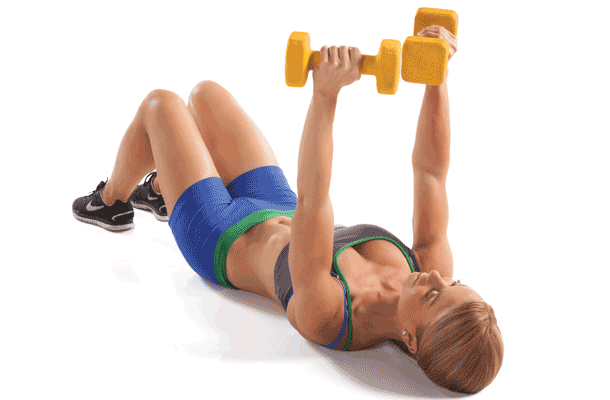If you are one of those who experience lower back pain with traditional bench presses Moving to the floor can help tremendously in reducing lumbar extension that comes from excessive arching on the bench. Besides, the bench press has its drawbacks. It can be brutal on the shoulders and rotator cuffs for some, while others simply don’t feel it in the chest and abandon it for a dumbbell or machine variation.

The floor press is a pure upper body movement that allows you to press massive weights without undue shoulder stress, maximizing your training efficiency and protecting your shoulders for long-term training and strength gains.
How to Perform?
Opt for one dumbbell for a couple of advantages. The free hand can help to get the weight in place. Also, pressing one arm at a time will increases the core demands of the exercise, as you have to brace to keep your torso steady.
- Lie down with your back flat on the floor, leg stretched.
- Hold a dumbbell in you right hand.
- Hold the dumbbell out to your side but pointed up towards the ceiling, elbow bent. You can experiment with different hand positions to figure out what feels best to you, but in general, utilizing a neutral grip with be easier on the shoulder joint.
- Push the dumbbell up towards the ceiling and then let it back down.
- This completes one repetition. Continue for the desired amount of reps and then switch arms.
- Perform five reps, followed by a five-second isometric hold in the bottom portion of the rep with the arms just off the floor. From there, go straight into four reps followed by a four-second hold, then three, then two, and finally one.
- Repeat with other hand.
- Relax.
Note: You can press with your legs straight or bend your knees. Each will change the dynamic of the exercise slightly. Pressing with straight legs increases the core demand because it eliminates your ability to use leg drive.

Benefits:
For women with shoulder issues, the dumbbell floor press is usually better tolerated than the traditional bench press due to the use of a neutral grip. Besides, pressing on the floor limits the range of motion slightly. This reduces extension at the shoulder joint while still providing a good training effect for the pecs and tricepss.
- Jacked Arms: The floor press requires powerful extension of the elbows, placing considerable mechanical tension on the triceps. Overloading the triceps with big weights is key to developing massive arms while keeping excessive joint stress at bay.
- Building Upper Body Power: Floor presses negate leg and lower body drive, creating a pure upper-body push. All the stress is focused on the chest, triceps, and shoulders, overloading them for pure strength gains.
- Improved Lockout: The limited range of motion and inherent pause of the floor press will help you if you tend to miss in the middle of your bench press.
- Easier on the Shoulders : Most big bencher face some degree of shoulder dysfunction. Most athletes flare the elbows in pressing movements, fixing the humerus into internal rotation. To accommodate this position the scapula rotates up and out, forcing scapular stabilizers to work overtime while rubbing on the supraspinatus ligament. This creates a marked decrease is sub-acromial space and increases impingement in the shoulder. The floor press reduces the range of motion of the shoulder and subsequent injury risk while still training a massive press.
Make sure to use a full range of motion on the press and try to keep your torso and legs as steady as possible for the duration of the set. This is harder than it looks, so start light!
Disclaimer
The Content is not intended to be a substitute for professional medical advice, diagnosis, or treatment. Always seek the advice of your physician or other qualified health provider with any questions you may have regarding a medical condition.


